Is Bordeaux The First Major Wine Region In Modern Times To Collapse?
The en primeur worked great for leading Bordeaux wineries. These wines need time to come into their own, yet en primeur sales generate cash-flow straight away. In addition, these sales take place without a proper assessment of quality.Over the last years, a number of developments happened and have started to form a perfect storm. First, early this century, Chinese buyers got into the market irrespective of price. The major US customers increasingly turned away. As the Chinese economy started to stall, and directions were given to stop drinking imported wine, this market fell away. In addition, younger consumers in the Western world increasingly turned off serious and intense red wine.Yet, not withstanding these trends, many wineries kept increasing en primeur prices year on year. As quality could not keep pace, prices in the secondary market could not match en primeur prices. The incentives to buy en primeur, securing supply and better prices, are no longer there.And now we have the 2024 vintage. It is a disaster. Flowering was poor, ripening is uneven, leading to longer hang time and exposure to mildew.The industry is putting its usual spin on the vintage, but volumes will be down, quality down as well. Prices must fall. It will be interesting to see how the wineries will cope.
The en primeur worked great for leading Bordeaux wineries. These wines need time to come into their own, yet en primeur sales generate cash-flow straight away. In addition, these sales take place without a proper assessment of quality.
Over the last years, a number of developments happened and have started to form a perfect storm. First, early this century, Chinese buyers got into the market irrespective of price. The major US customers increasingly turned away. As the Chinese economy started to stall, and directions were given to stop drinking imported wine, this market fell away. In addition, younger consumers in the Western world increasingly turned off serious and intense red wine.
Yet, not withstanding these trends, many wineries kept increasing en primeur prices year on year. As quality could not keep pace, prices in the secondary market could not match en primeur prices. The incentives to buy en primeur, securing supply and better prices, are no longer there.
And now we have the 2024 vintage. It is a disaster. Flowering was poor, ripening is uneven, leading to longer hang time and exposure to mildew.The industry is putting its usual spin on the vintage, but volumes will be down, quality down as well. Prices must fall. It will be interesting to see how the wineries will cope.











